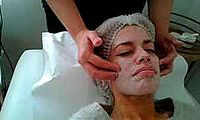peeling
Peeling ( English to peel , peel ',' peel ') or peeling cure is a cosmetic or dermatological treatment in the superficial layers of the skin are extensively removed.
In the sense in which the word "peeling" is used in German, it is a sham Anglicism . In English, the term scrubbing or, more formally, exfoliation is used for the process that is so called in German . Peeling in relation to skin refers to injured skin that peels off itself - for example after sunburn .
species
With superficial peeling , the top horny layer of the skin is removed mechanically or chemically. This treatment is colloquially known as peeling ; many providers refer to this method as microdermabrasion .
With the medium-depth peeling, the entire horny layer is chemically removed. This has to be prepared in the long term and takes about a week to heal.
With deep peeling , the skin is removed down to the collagen layer. The healing takes several weeks. This procedure is rarely used in Europe.
Mechanical peeling
As part of mechanical peeling treatments, the following are used:
- Aluminum oxide microparticles (Brasivil peeling paste)
- Polydimethyl Silicone Resin Microparticles (Jaikin N Paste)
- Salt crystals
- Coridon crystals
- Sugar crystals
- hard brushes
- Microfiber cloths
- Clay
- sand
- Coffee grounds (popular in Japan)
- Plastic particles
- Crushed or ground kernels of e.g. B. peaches or apricots
- Wax (e.g. rice bran wax )
- Liquid nitrogen (acts superficially to medium-deep)
Chemical peel
The following substances are used for chemical peeling treatments:
- Fruit acids (has a superficial effect, e.g. glycolic acid)
- β-lipohydroxy acid (LHA) (acts superficially)
- Trichloroacetic acid (TCA) (medium-deep effect)
- Phenolic compounds (deep action)
- Tretinoin (vitamin A acid)
Laser peeling
An Erbium peel works with a YAG laser, is quite deep, has a longer healing time of around 1 week and can lead to redness that can last around 2 to 4 weeks. There is also the so-called pulsed carbon dioxide laser, which has a deep effect, but has a longer healing time of around 1 week, the reddening can last around 1 to 4 months.
history
In ancient Egypt, treatments that correspond to today's superficial peeling are said to have been common. In the Turkish bath ( hammam ), a full body treatment is traditionally carried out with a glove made from goat hair. In Europe, peeling has only been widespread since the 1960s.
Nowadays, superficial peeling removes the top horny layer of the skin mechanically or chemically.
application
Peeling is used against:
- Pigment spots (e.g. age spots ), pigment disorders
- Lines, wrinkles and wrinkles (see skin aging )
- Blemishes, enlarged pores
- certain forms of acne
- Hyperkeratosis
- Scarring skin
Effects of mechanical peeling
A mechanical peeling is supposed to increase the elasticity and firmness of the skin and to shrink the "pores". The depth of the wrinkles is reduced and the skin's absorption of active ingredients is optimized. The skin's own collagen and elastin production (depth effects) are also activated.
Mostly peeling is used on the face , hands and décolleté , a superficial peeling is also used as a full body treatment.
Mode of action
Basically, the stronger the peeling, the deeper the skin layers are removed. Chemical peelings (acids) cause the protein in the skin to coagulate (denature it). For example, with a trichloroacetic acid peeling, “frosting” occurs. H. a white layer of destroyed protein becomes visible. The strength of an acid peeling depends on the concentration used, the duration of exposure and how much it is "rubbed" into the skin. The stronger the peeling, the more intense the effects, but the more side effects have to be taken into account.
Risks
- The superficial peeling brings hardly any risks. However, intensive mechanical treatment of the skin promotes cornification . People with a venous disorder, especially couperose (mostly in the area of the nostrils ), should refrain from peeling, as peeling promotes the growth of spider veins.
- The greatest danger is from wart virus infections . This can be seen in the facial skin of actors who, as a result of poor hygiene on the part of the makeup artist, show a large distribution of skin warts. Prevention or defense against wart infections that have already been caused after the peeling is recommended.
- The following risks exist with medium and deep peeling:
- Infections ,
- Damage to deeper skin layers,
- unintended chemical burns if the acids are used improperly,
- Phenol is carcinogenic and damaging to the heart
- Scarring: unlikely if all advice is followed by a doctor
- Permanent pigmentation disorders, favored by the use of hormonal contraceptives and by UV radiation
- Sensitivity to UV rays: The sun should definitely be avoided for a few months after a peeling. When you go out of the house, you should apply sunscreen with an appropriate sun protection factor, and in the summer when the sun is strong, you should definitely use a very high sun protection factor.
Single receipts
- ↑ a b Klaus Karl Degitz, Hanns-Juergen Krauss: pathogenesis, clinical and pharmacotherapy of acne (= Series of the Bavarian Chamber of Pharmacists. H. 69). GOVI-Verlag, Eschborn 2004, ISBN 3-7741-1021-2 , p. 59: 2.3 Abrasiva. Full text .
